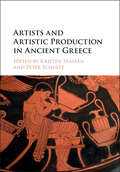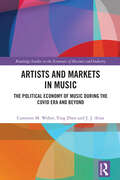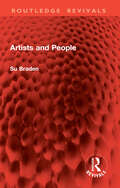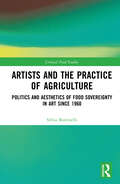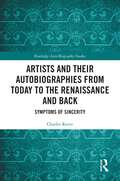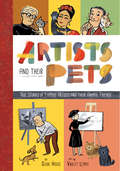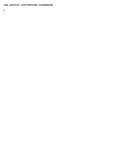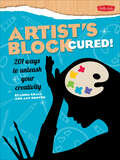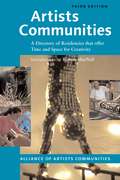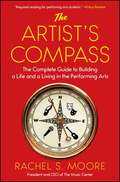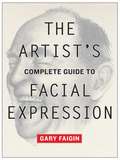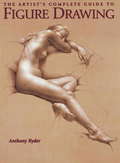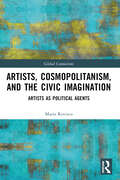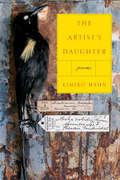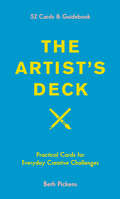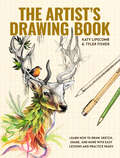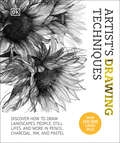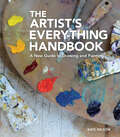- Table View
- List View
Artists and Artistic Production in Ancient Greece
by Kristen Seaman Peter SchultzGreek artists and architects were important social agents who played significant roles in the social, cultural, and economic life of the ancient Greek world. In Artists and Artistic Production in Ancient Greece, art historians, archaeologists, and historians explore the roles and impacts of artists and craftsmen in ancient Greek society. The contributing authors draw upon artistic, architectural, literary, epigraphical, and historical evidence to discuss a range of artists, architects, artistic media, and regions. They refer to historiography and modern theory, taking stock of the past while offering some new directions for future research. Incorporating a variety of methodological approaches and making use of often-neglected evidence, Artists and Artistic Production in Ancient Greece re-examines many long-held ideas and provides a deeper understanding of particular artists and architects, their works, and their social agency.
Artists and Markets in Music: The Political Economy of Music During the Covid Era and Beyond (Routledge Studies in the Economics of Business and Industry)
by Cameron M. Weber Ying Zhen J.J. AriasThis monograph is an innovative examination of the political economy of music. It integrates original economic theories and empirical research to shed light on the economic and social forces shaping music and society today. Interactive relationships, such as the importance of entrepreneurship, serendipity and authenticity, will be explored in artist subjective determinations of success. In particular, this book deeply explores the mental health of musicians and "creative destruction" during the covid era, copyrights in music markets and an evaluation of the importance of entrepreneurship and brand marketing in the life of musical artists. The monograph contributes empirical research to underexplored areas in the cultural economics of music, such as the proposed musical production function by Samuel Cameron (Routledge 2015) and the concept of distinction in cultural production by Pierre Bourdieu (Routledge 1984, 2010) as uniquely applied with examples from the covid era. Readers will benefit from this easy-to-understand interdisciplinary exploration of the music industry with a focus on the United States and the political economy of music during the covid era. Most cultural economics is focused on Europe and Asia, so this emphasis on the United States will be of interest. This book will be a beneficial reference work for researchers and will find an audience among music professionals and artists. Academics and non-academics, experts and novices interested in music and political economy will also find value in Artists and Markets in Music.
Artists and Patrons in Post-war Britain
by Courtauld Institute of ArtThis title was first published in 2001. An examination of art and patronage in Britain during the post-war years. It consists of five case studies, initially written as MA theses, that closely investigate aspects of the mechanisms of patronage outside the state institutions, while indicating structural links within it. The writers have sought to elucidate the relationship between patronage, the production of art and its dissemination. Without seeking to provide an inclusive account of patronage or art production in the early post-war years, their disparate and highly selective papers set up models for the structure of patronage under specific historical conditions. They assume an understanding that works of art are embedded in their social contexts, are products of the conditions under which they were produced, and that these contexts and conditions are complex, fluid and imbricated in one another.
Artists and People (Routledge Revivals)
by Su BradenFirst published in 1978, Artists and People examines the formal attempts by arts administrators to set up schemes for artists to work in community contexts. The experience of creative artists who have taken up ‘residencies’ in schools, libraries and art centres is contrasted with the unique forms of expression developed by local communities themselves in new towns, housing estates, rural centres, and inner cities, in areas ranging from Tower Hamlets in London, through Craigmillar in Scotland, to new towns such as Telford and Milton Keynes.The book takes the form of a series of accounts of the experiences of artists and communities who have come together in contexts not usually seen as arenas for the arts. Su Braden looks at these experiences in the light of the philosophy that the right to artistic expression is a basic human freedom for everybody, not just for ‘artists’. In writing the book she has drawn on her experience as a community arts worker and she assesses the effect of the traditional structures (the theatre, gallery and concert hall) both on the form of art itself and the critical relationship which is intrinsic to its development. By looking at the first-hand experience of artists and local people, she has documented the dependence of much contemporary art for its form and the nature of its critical relationships on the formal structure offered by traditional outlets. In contrast, the examination of the relationship between artists and communities who have developed creative forms out of a more spontaneous recognition of mutual needs and talents reveals a new perspective on the social value of liberating artistic expression from its formal restraints.
Artists and Signatures in Ancient Greece
by Jeffrey M. HurwitThe Greeks inscribed their works of art and craft with labels identifying mythological or historical figures, bits of poetry, and claims of ownership. But no type of inscription is more hotly debated or more intriguing than the artist's signature, which raises questions concerning the role and status of the artist and the work of art or craft itself. In this book, Jeffrey M. Hurwit surveys the phenomenon of artists' signatures across the many genres of Greek art from the eighth to the first century BCE. Although the great majority of extant works lack signatures, the Greek artist nonetheless signed his products far more than any other artist of antiquity. Examining signatures on gems, coins, mosaics, wall-paintings, metalwork, vases, and sculptures, Hurwit argues that signatures help us assess the position of the Greek artist within his society as well as his conception of his own skill and originality.
Artists and the Arab Uprisings
by Lowell H. Schwartz Dalia Dassa Kaye Jeffrey MartiniRegional artists can play a positive role in shaping public debate and supporting democratic transition in the Middle East. This report explores the challenges artists have faced since the Arab uprisings, U. S. government programs to support arts in the region, and the wide array of nongovernmental activities to engage Arab artists, offering recommendations to improve support for these artists.
Artists and the Practice of Agriculture: Politics and Aesthetics of Food Sovereignty in Art since 1960 (Critical Food Studies)
by Silvia BottinelliArtists and the Practice of Agriculture maps out examples of artistic practices that engage with the aesthetics and politics of gathering food, growing edible and medicinal plants, and interacting with non-human collaborators. In the hands of contemporary artists, farming and foraging become forms of visual and material language that convey personal and political meanings. This book provides a critical analysis of artistic practices that model alternative food systems. It presents rich academic insights as well as 16 conversations with practicing artists. The volume addresses pressing issues, such as the interconnectedness of human and other-than-human beings, the weight of industrial agriculture, the legacy of colonialism, and the promise of place-based and embodied pedagogies. Through participatory projects, the artists discussed here reflect on the links between past histories, present challenges, and future solutions for the food sovereignty of local and networked communities. The book is an easy-to-navigate resource for readers interested in food studies, visual and material cultures, contemporary art, ecocriticism, and the environmental humanities.
Artists and Their Autobiographies from Today to the Renaissance and Back: Symptoms of Sincerity (Routledge Auto/Biography Studies)
by Charles ReeveReading life writing that runs from Tracey Emin, Faith Ringgold and Judy Chicago to Marie Bashkirtseff, Benvenuto Cellini and beyond, Artists and Their Autobiographies from Today to the Renaissance and Back investigates the intriguing doubled truths of artists’ autobiographies: truth in life and truth in art; authorial truth/s and the truth of their art as they saw it. However, this book focuses specifically on the truth of sincerity, which here—following classic discussions by Reindert Dhondt, Philippe Lejeune and Lionel Trilling—appears as a truth to self that floats free from facts to link avowal and feeling. From there, this volume merges autobiography studies with a history of ideas approach to art to trace sincerity’s constancy and variability across times and cultures. Through this pre-disciplinary dialogue, this book shows that recent and historical artists’ autobiographies differ in how, not if, they intertwine sincerity in life and art. Along the way, this volume leverages the foregrounding of sincerity caused by this doubling to explore such key issues of autobiography studies as autobiography’s relation to fiction, serial autobiography, "as-told-to" narrative and what happens when liars claim to tell all.
Artists and Their Pets: True Stories of Famous Artists and Their Animal Friends
by Susie Hodge Violet LemayDid you know that the great Pablo Picasso had many pets, including a white mouse and a goat? And that Andy Warhol loved his dachshunds, Salvador Dalí liked ocelots and anteaters, and Georgia O’Keeffe had a passion for chows and Siamese cats? Artists and Their Pets tells these stories and many more with full-color illustrations and a chirpy narrative that will delight both art buffs and pet enthusiasts. Lexile: 1140L
The Artists' And Writers' Cookbook: A Collection Of Stories With Recipes
by Natalie Eve Garrett Amy Jean PorterIn The Artists' and Writers' Cookbook,Anthony Doerr lures us out into the wild to find huckleberries andhappiness. Neil Gaiman makes a perfectly eerie cheese omelet while Ed Ruschaassociates his cactus omelet with "a time of doom." Yiyun Li eats rations inBeijing while Edwidge Danticat prepares a soup to celebrate freedom. NelsonDeMille reminisces about a meal he ate 40 years ago when serving in Vietnam;Kamrooz Aram recalls childhood "picnics" in his basement in Tehran during airraids. Sanford Biggers updates a soul food classic-"something tasty to lessenthe bitter taste of consistent, systematic oppression." Paul Muldoon and AimeeBender conjure food-related apocalyptic visions. Marina Abramović shares adish best consumed on top of a volcano, Elissa Schappell dreams of playing SergeGainsbourg records to snails, and Padgett Powell tastes a dish that reverses timeand space. Daniel Wallace woos with an eggplant sandwich. Francesca Lia Blocktells us how to fall in love.
Artists At Work
by Bernard ChaetChaet explores the relationship between an artist's materials and technique, and the forms in which he expresses his vision. He shows that technique and vision are inseparable.
Artist's Block Cured!: 201 Ways to Unleash Your Creativity
by Linda Krall Amy RunyenHere are a multitude of ways to help you move outside your comfort zone and into the realm of heightened creativity for when you need an inspiration boost.Beginning and advanced artists alike have experienced “artist’s block” at some point in their endeavors. Now artists can turn to this book in their time of need. Artist’s Block Cured! provides a stimulating array of ideas for beating blank canvas syndrome and conquering other creative ailments. Broken down into six color-coded categories, beginners will find activities, lessons, quizzes, and inspiration from the Masters to help jumpstart creativity. Written by creative thinker and illustrator Linda Krall and artist Amy Runyen, this book is an effective and entertaining tool no artist should be without!Overcome your obstacles with six color-coded categories:Assignments—Creativity-boosting challenges and step-by-step projectsInspiration—Encouraging and stimulating suggestions for rethinking your artworkMental Exercises—Prompts for generating creative thoughtsExperiments in Media—Exercises and projects that use innovative materialsGames—Activities that encourage play and interactionArtist’s Spotlight—Valuable insight from experienced artists
Artists Communities: A Directory of Residencies that Offer time and Space for Creativity (Artists Communities: A Directory Of Residences That Offer Time And Spa Ser.)
by The Alliance of Artists' Communities Robert MacneilThe bible of creative residency programs returns, with fresh information and new features for artists of all disciplines. More than 300 programs worldwide are described, with 95 leading communities featured in two-page spreads with photographs. The user-friendly layout allows for quick scans of facility descriptions, deadlines, fees, selection processes, odds of acceptance, special programs, and more. For artists seeking to boost their creativity in a fresh and inspiring setting, Artists' Communities is the definitive sourcebook.
The Artist's Compass: The Complete Guide to Building a Life and a Living in the Performing Arts
by Rachel MooreAn inspiring, real world guide for artists in the classic bestselling tradition of What Color Is Your Parachute? that shows how to build a successful, stable career in the performing arts, from the President and CEO of the Los Angeles Music Center who has carved her own success through her creative talent and business skill.While performing artists have many educational opportunities to perfect their craft, they are often on their own when it comes to learning the business skills necessary to launch their careers. At the end of the day, show business is, well, a business. In The Artist's Compass, Los Angeles Music Center CEO Rachel Moore shares how to make life as a performer more successful, secure, and sustainable by approaching a career in the arts like an entrepreneur. A former dancer in the American Ballet Theatre's corps de ballet, Moore knows firsthand what it's like to struggle and succeed as an artist. Now in an offstage role as CEO, Moore shares the hard-won lessons she's learned about making one's own success and encourages every performer to develop creative talent alongside marketable skills. With testimonials from artists like Lang Lang, Sigourney Weaver, and Renee Fleming, plus inspiring anecdotes from Moore's own journey in the arts, The Artist's Compass teaches aspiring performers how to think like an entrepreneur to create their own brand and marketing platform to achieve personal and professional success. In an engaging, realistic, and authoritative voice, Moore combines her artistic and corporate experience to address the finer points of building a career in a challenging industry, teaching young performers how to achieve financial independence so that they might have creative independence.
The Artist's Complete Guide to Drawing the Head
by William MaughanIn this innovative guide, master art instructor William Maughan demonstrates how to create a realistic human likeness by using the classic and highly accurate modeling technique of chiaroscuro (Italian for "light and dark") developed by Leonardo da Vinci during the High Renaissance.Maughan first introduces readers to the basics of this centuries-old technique, showing how to analyze form, light, and shadow; use dark pencil, white pencil, and toned paper to create a full range of values; use the elements of design to enhance a likeness; and capture a sitter's gestures and proportions. He then demonstrates, step by step, how to draw each facial feature, develop visual awareness, and render the head in color with soft pastels.
The Artist's Complete Guide to Facial Expression
by Gary FaiginArtists love this book, the definitive guide to capturing facial expressions. In a carefully organized, easy-to-use format, author Gary Faigin shows readers the expressions created by individual facial muscles, then draws them together in a section devoted to the six basic human emotions: sadness, anger, joy, fear, disgust, and surprise. Each emotion is shown in steadily increasing intensity, and Faigin's detailed renderings are supplemented by clear explanatory text, additional sketches, and finished work. An appendix includes yawning, wincing, and other physical reactions. Want to create portraits that capture the real person? Want to draw convincing illustrations? Want to show the range of human emotion in your artwork? Get The Artist's Complete Guide to Facial Expression!From the Trade Paperback edition.
The Artist's Complete Guide to Figure Drawing
by Anthony RyderMany of us want to learn "how to draw." But as artist Anthony Ryder explains, it's much more important to learn what to draw. In other words, to observe and draw what we actually see, rather than what we think we see. When it comes to drawing the human figure, this means letting go of learned ideas and expectation of what the figure should look like. It means carefully observing the interplay of form and light, shape and line, that combine to create the actual appearance of human form. In The Artist's Complete Guide to Figure Drawing, amateur and experienced artists alike are guided toward this new way of seeing and drawing the figure with a three-step drawing method.The book's progressive course starts with the block-in, an exercise in seeing and establishing the figure's shape. It then build to the contour, a refined line drawing that represents the figure's silhouette. The last step is tonal work on the inside of the contour, when light and shadow are shaped to create the illusion of form. Separate chapters explore topics critical to the method: gesture, which expresses a sense of living energy to the figure; light, which largely determines how we see the model; and form, which conveys the figure's volume and mass. Examples, step-by-steps, and special "tips" offer helpful hints and practical guidance throughout.Lavishly illustrated with the author's stunning artwork, The Artist's Complete Guide to Figure Drawing combines solid instruction with thoughtful meditations on the art of drawing, to both instruct and inspire artists of all levels.
The Artist's Complete Health and Safety Guide: Konqueror, Kdevelop, Opera, Calligra Suite, Skype, Amarok, Kde Software Compilation 4, Vlc Media Player, Kontact, K3b, Scribus, Digikam, Ktorrent, Rekonq, Clementine, Doxygen, Kvirc, Musescore, Konversation, Umbrello, Kget, Kopete
by Monona RossolDozens of at-a-glance tables and charts present vital information about art materials, ingredients, technical hazards, proper protective equipment, and safe work practices simply and accurately. This brand-new third edition is now completely revised and expanded to detail lifesaving new safety and ventilation equipment, present urgent new discoveries on toxins and pollutants found in arts and crafts materials, and explain the controversies surrounding new government regulations. A virtual lifesaver for all art and craft workers.
Artists, Cosmopolitanism, and the Civic Imagination: Artists as Political Agents (Global Connections)
by Maria RoviscoArtists, Cosmopolitanism, and the Civic Imagination unpacks the political agency of artists by looking at artists as moral, reflexive, and political agents. Do artists play a role in civil society? Can artists “make a difference” in the world? In what ways do artists act politically? To address these questions, this book moves away from a focus on social organisation and the production of art, to ask how artists attach meaning to their interventions in social and political conditions.Maria Rovisco draws from in-depth interviews with UK-based visual artists and theatre practitioners with a migrant background, and semiotic analysis of a theatre play, visual artworks, and film texts, to argue that artists are quintessential cosmopolitans who care deeply about changing society for the better. By explaining how artists get involved in cross-cultural encounters, this book reveals the processes of listening, reflection, imagination, social learning, and moral intentionality through which artists imagine and realise their visions of a better world. In so doing, it offers a new direction in thinking about the intersection of art and politics, by showing how artists play a crucial role in building a civic culture outside traditional sites of political participation.This book will be essential reading for students and scholars across the social sciences and the humanities with interests in migration, citizenship and the public sphere, cultural sociology, media and culture, cosmopolitanism, and art.
The Artist's Daughter: Poems
by Kimiko Hahn"Kimiko Hahn stands as a welcome voice of experimentation and passion."--Bloomsbury Review Kimiko Hahn's poetry explores the interplay--and tensions--among her various identities: mother, lover, wife, poet, and daughter of both the Midwest and Asia. However astonishing her subjects--from sideshow freaks to sadomasochistic fantasy--they ultimately emerge in this startling collection as moving images of the deepest levels of our shared humanity.
The Artist's Deck: Practical Cards for Everyday Creative Challenges
by Beth PickensA healing tool that empowers creatives of all types to confront their shadows and embrace their art. Whether you are grappling with jealousy, rejection, imposter syndrome, or over-commitment, this 52-card deck can help you face your fears and transmute them into opportunities for expansion, creativity, and growth.Creative roadblocks are a fact of life for every artist, and every artist needs tools to help them clear the path. Enter The Artist's Deck, created by arts counselor and author Beth Pickens, to help you return to your art, no matter what obstacles you encounter.In this handy, interactive card deck, Pickens identifies common traps, feelings, myths, and blocks that artists encounter and offers insight into working through each one. Each card describes an obstacle and poses reflection questions and exercises to transform that obstacle into a source of inspiration and generative energy. Whether you seek guidance on a specific topic or use the deck as an oracle tool to inspire growth, The Artist's Deck will support you as you work through the creative challenges that come your way.CREATIVITY + SELF-CARE: Mindfulness Cards meet The Artist’s Way in this self-help tool crafted specifically for artists. Select a card and develop a practice of reflection and action to acknowledge your anxieties, consider new perspectives and approaches, and overcome creative hurdles with self-awareness and self-compassion.EXPERT AUTHOR: Beth Pickens holds a master’s degree in counseling psychology and has a long history of experience advising and supporting artists and arts organizations. She is perfectly positioned to offer advice on navigating the many challenges—structural and internal, practical and metaphysical—that artists face. A VERSATILE TOOL: The Artist's Deck is portable, adaptable, succinct, and flexible—it's a hands-on, tactile tool for disrupting the patterns that keep you from making your art. Keep it in your bag and reach for it whenever you need it, whether you're at home, in the studio, on a train, in an office, or going off the grid at an immersive retreat.Perfect for:Artists, illustrators, designers, and other visual creativesCrafters, creative hobbyists, and aspiring makers of all kindsPeople experiencing creative blocks or struggling with imposter syndromeOracle card and tarot deck enthusiastsGift shoppers seeking a meaningful gift for creative and artistic family and friendsArts consultants, creativity and life coaches, and their clientsFans of Beth Pickens and Make Your Art No Matter What
The Artist's Drawing Book: Learn How to Draw, Sketch, Shade, and More with Easy Lessons and Practice Pages
by Katy Lipscomb Tyler FisherSpark your creativity and hone your drawing skills with this comprehensive art book for beginners—which includes interactive lessons and fun practice pages!Join master artists Katy Lipscomb and Tyler Fisher as they guide you step-by-step through the art-making process. Using their Sketching Formula, anyone from beginners to experienced artists can improve their drawing abilities, expand their imagination, and achieve their creative potential. Filled with tips, tricks, and techniques, this interactive workbook guides you through a vast array of artistic approaches while inspiring your unique style.From comprehensive lessons that cover the basics of art theory to unique practice prompts that will get your creative juices flowing, The Artist's Drawing Book will teach you:• The fundamentals of art, like perspective, shading, composition, and color theory—all broken down into easy-to-digest lessons• Tips for avoiding common beginner mistakes, so you can confidently sketch any subject• Tricks for realistic texture, blending, and shading, no matter if you're working with professional-grade colored pencils or a cheap ballpoint pen• Techniques for mixing mediums so you can be limitless when creating your artwork• How to view the world like a true artist, so you can overcome creative block and find artistic inspiration wherever you go• ...and many more invaluable tips and tricks!If you're ready to start drawing as you learn how to develop your artistic abilities, The Artist's Drawing Book will encourage hands-on action to help you bring your artistic dreams to fruition.Also features:• Premium 140 gsm paper—perfect for testing out your new art skills• A sturdy hardcover with layflat design• Interactive activities so you can draw alongside each lesson• More than 200 pages of content• Over 700 inspiring illustrations• Valuable tips, tricks, and insights from the pros• Creative prompts, ideas, and inspiration• Suitable for all skill levels
Artist's Drawing Techniques: Discover How to Draw Landscapes, People, Still Lifes and More, in Pencil, Charcoal, Pen and Pastel
by DKThe ultimate complete drawing course to help you take your sketches to a higher level.Packed with inspiring workshops and advice from practicing artists, this art lesson book will help you sharpen your drawing skills in a range of media. Here&’s what you&’ll find inside the pages of this artist&’s guide to drawing: • Includes more than 90 detailed step-by-step workshops for pencil, charcoal, pen and pastel techniques • A comprehensive range of techniques makes it suitable for beginners or more experienced artists • Techniques are approached with progression in mind, so readers can learn the basics then move on to new creative challenges Every aspect of drawing is explained in incredible detail in this drawing reference guide. It starts with the basics of drawing — like learning how to draw and choosing a subject — and works all the way through to mounting your finished masterpiece. Learn more than 80 drawing techniques, from cross-hatching and stippling to blending and using colored pencils. Develop your own artistic style and grow as an artist by following the step-by-step drawing tutorials through beginner, intermediate and advanced art projects. Artist's Drawing Techniques will help you tap into your creative potential and unlock new talents, whether you&’re a complete beginner or seasoned artist.
Artists Emerging: Sustaining Expression through Drawing (Routledge Revivals)
by Sheila Paine Tom PhillipsThis title was first published in 2000. Most children enjoy drawing and use it to express a wide range of experiences and emotions. Drawing can offer an avenue of expression where words fail. So why do many people stop drawing after the early school years? This is an examination of the early work of John Everett Millais, Henri de Toulouse-Lautrec, Pablo Picasso, Michael Rothenstein, Gerard Hoffnung, Sarah Raphael and David Downes to investigate the reasons why these artists were able to sustain and develop their drawing skill and expressive potential while others failed. The close study of these artists' early drawings reveals their sequences of progress and their eventual achievement. Sheila Paine, a former President of the National Society for Education in Art and Design, shares the experience of a lifetime's work in art education to explore the mysteries of drawing fluency, its often precocious beginnings, and the personal, social and cultural circumstances which help or hinder its development.
The Artist's Everything Handbook: A New Guide to Drawing and Painting
by Kate WilsonThe Artist’s Everything Handbook is your complete guide to the fundamentals of artistic creation. Encompassing a diverse range of drawing, sketching, and painting techniques—from pen and ink to oils and acrylics—you’ll find everything you need to create daring and imaginative works of art.Divided according to medium, each section offers an informative overview and a thorough exploration of all the relevant tools and materials. Chapters suggest innovative ways to tackle your subjects, and provide specially commissioned illustrations with detailed tutorials and helpful tips. Learn how to properly mix paint colors, take a small object and scale it up, and play with the idea of positive and negative space. Inside, you’ll also find galleries of contemporary artwork that demonstrate the range of effects that can be achieved using a particular technique. Acknowledging the growing interest in digital media, this book also includes information on how certain effects can be re-created using programs such as Photoshop and drawing apps. And finally, artist profiles offer insight into the working processes of some of today’s emerging painters and drawers from all around the world.Filled with imaginative ideas and tutorials, varied and inspiring work from young contemporary artists, and a fresh, modern approach to old art forms, this book is your essential reference to dive into the boundless possibilities of drawing and painting.
